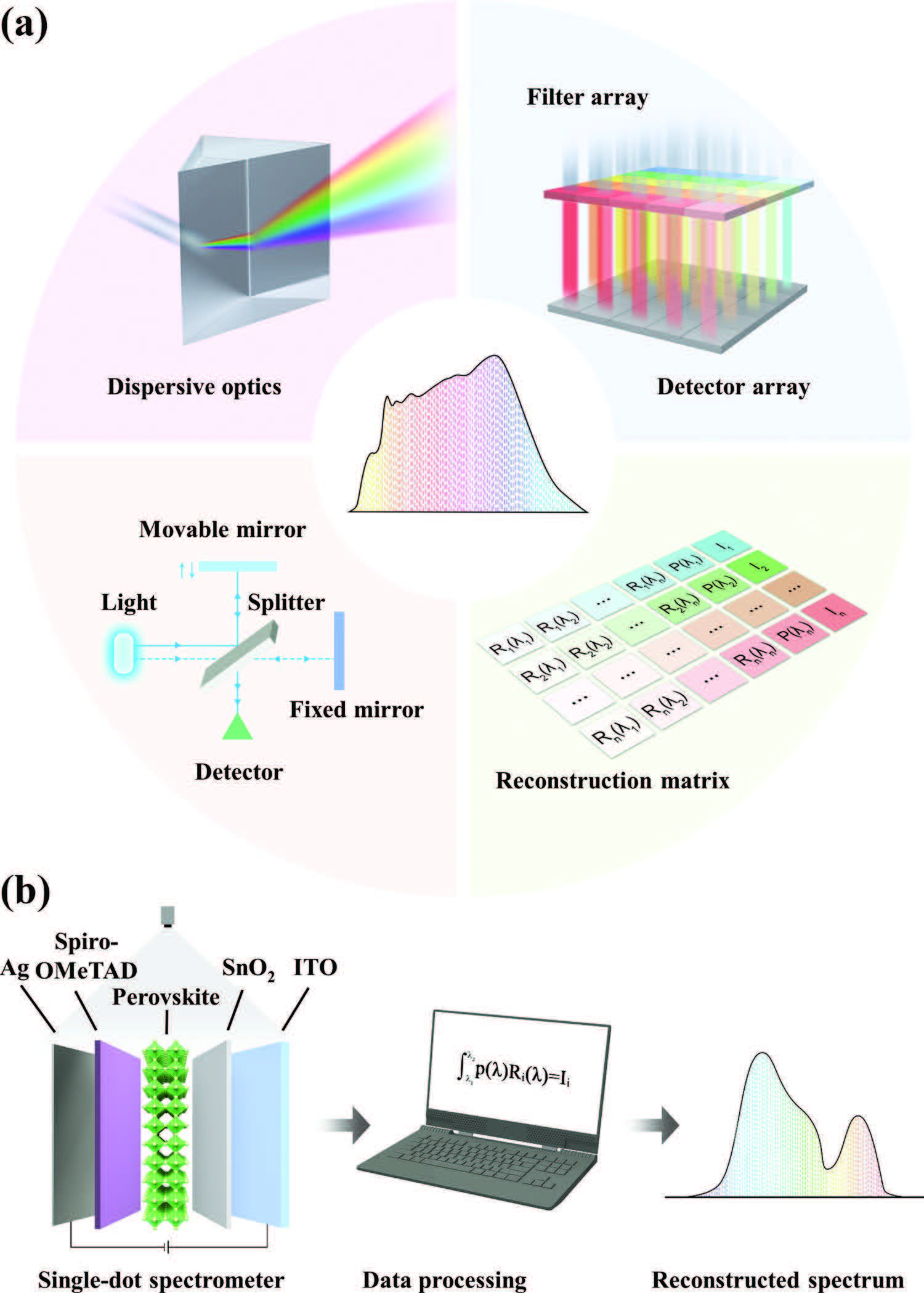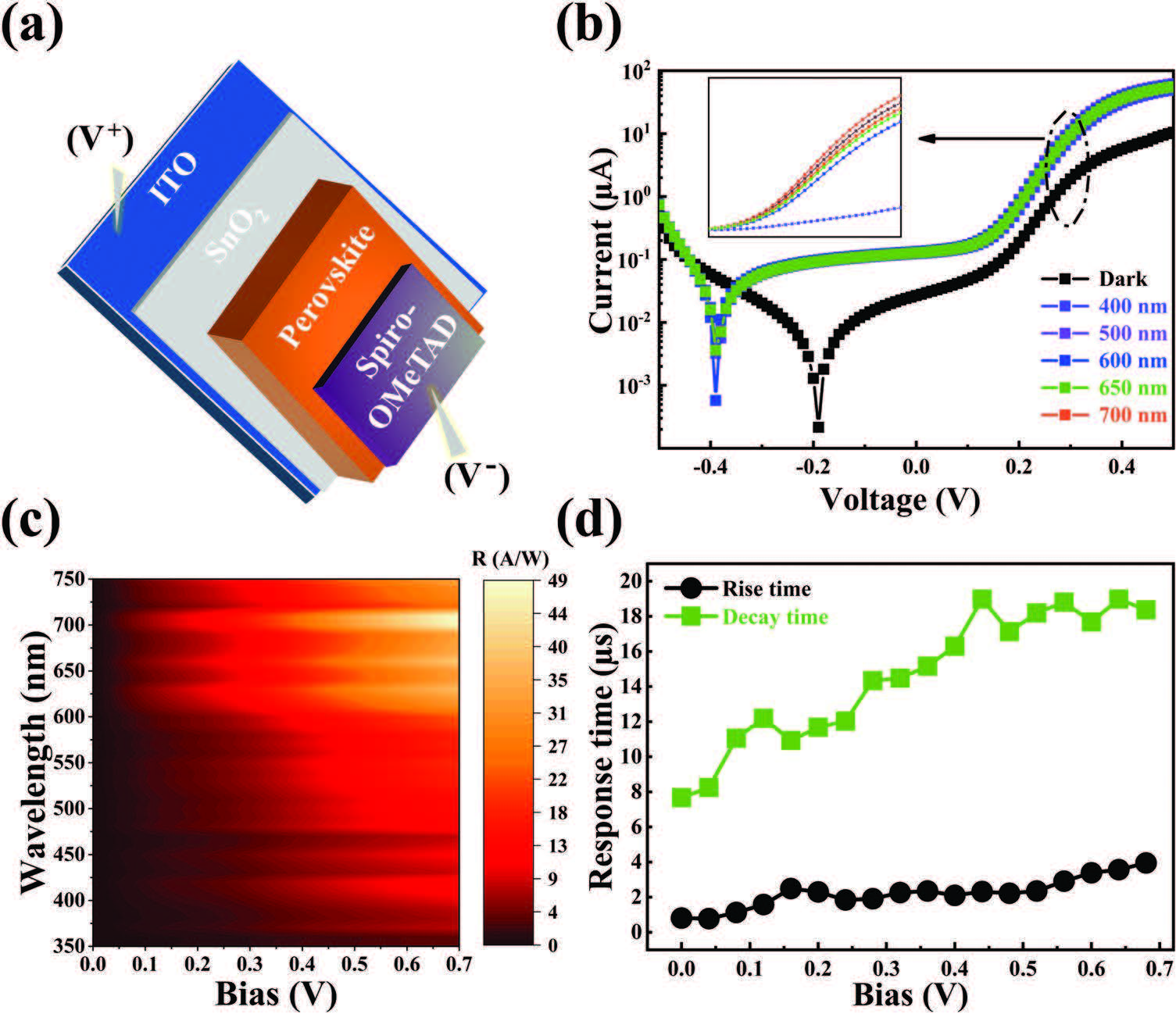| Oct 13, 2022 | |
Breaking the footprint-resolution restriction of spectrum analysis with a single-dot perovskite spectrometer |
|
| (Nanowerk Spotlight) Optical spectrometers are devices that measure the variation in the absorption and emission of light over a range ( the change in the absorption and emission of light with wavelength) of wavelengths. These scientific devices are used to determine the chemical composition of everything from laboratory materials to distant stars. | |
| Traditionally, spectrometers have been bulky and expensive laboratory instruments used to detect and identify the molecules inside a sample by shining light on it and measuring different wavelengths of the emitted or absorbed light. | |
| In an effort to reduce their size, researchers have been working on developing miniature on-chip spectrometers that could be integrated into small handheld devices or even smartphones. | |
| Reducing the size down to the micrometer scale, researchers at the Center for Energy Conversion Materials and Physics at Soochow University in China have developed a single-dot spectrometer based on an in situ modulated perovskite photodetector. The device is enabled by photogain manipulation controlled by ion redistribution in the perovskite film under an externally applied bias. | |
| The team reports their findings in Advanced Materials ("A Single-Dot Perovskite Spectrometer"). | |
| As a single device, without any optical or mechanical component, this spectrometer has a footprint of 440 × 440 µm2 and the spectral resolution can reach about 5 nm. The response time can down to about 197 µs owing to the ultrafast optical response of perovskite. | |
| As illustrated below, the most prominent strategies of spectrometers can be grouped into four categories: 1) Dispersion elements are utilized to achieve the separation of spectral components; 2) filters that selectively transmit light of a specific wavelength are integrated with the detector; 3) a Fourier transform system is utilized to analyze the spectrum; and 4) a recently developed scheme that exploits computational techniques to reconstruct the incident spectrum from the pre-set spectrum detection information. | |
| In contrast, this work is the first to propose a perovskite device based on in situ dynamic modulation, extending into a new field for perovskite functional devices and exerting a significant role in hyperspectral remote sensing and ultrahigh-resolution imaging. | |
 |
|
| Classification of the mechanism of the spectrometer. a) Mechanisms from previous literature and b) schematic showing the mechanism of the single-dot perovskite spectrometer. (Reprinted with permission by Wiley-VCH Verlag) | |
| The working mechanism of the single-dot perovskite spectrometer is derived from the reconstructive spectrometer, which is illustrated in Figure b above. The detector is illuminated by an unknown incident light P(λ), and a photocurrent measuring instrument records the current value I generated from the detector at different biases, followed by data analysis. A mapping relationship can be established between P and I via the photoresponsivity R, and finally, P(λ) can be reconstructed by solving a system of linear equations. | |
| Light with different frequencies possesses different penetrating capabilities for perovskites. This is exploited by this single-dot spectrometer, which tunes the spectral responsivity of a single detector through controlling the ion migration in the active layer by external bias (unlike other reconstructive spectrometers, which integrate multiple detectors to realize the breadth of responsivity). | |
 |
|
| Performance evaluation of the single-dot spectrometer. a) Schematic showing the structure of the single-dot spectrometer. b) I–V curves of the spectrometer when irradiated by monochromatic light at various wavelengths. c) Photoresponsivity of the spectrometer as a function of the applied bias and wavelength. d) Relationship between the response time and external bias voltage. (Reprinted with permission by Wiley-VCH Verlag) | |
| This unique spectrometer design breaks the footprint-resolution restriction of spectrum analysis and leads to a new design direction of perovskite in situ modulation for the development of new functional devices. | |
 By
Michael
Berger
– Michael is author of three books by the Royal Society of Chemistry:
Nano-Society: Pushing the Boundaries of Technology,
Nanotechnology: The Future is Tiny, and
Nanoengineering: The Skills and Tools Making Technology Invisible
Copyright ©
Nanowerk LLC
By
Michael
Berger
– Michael is author of three books by the Royal Society of Chemistry:
Nano-Society: Pushing the Boundaries of Technology,
Nanotechnology: The Future is Tiny, and
Nanoengineering: The Skills and Tools Making Technology Invisible
Copyright ©
Nanowerk LLC
|
|
|
Become a Spotlight guest author! Join our large and growing group of guest contributors. Have you just published a scientific paper or have other exciting developments to share with the nanotechnology community? Here is how to publish on nanowerk.com. |
|
